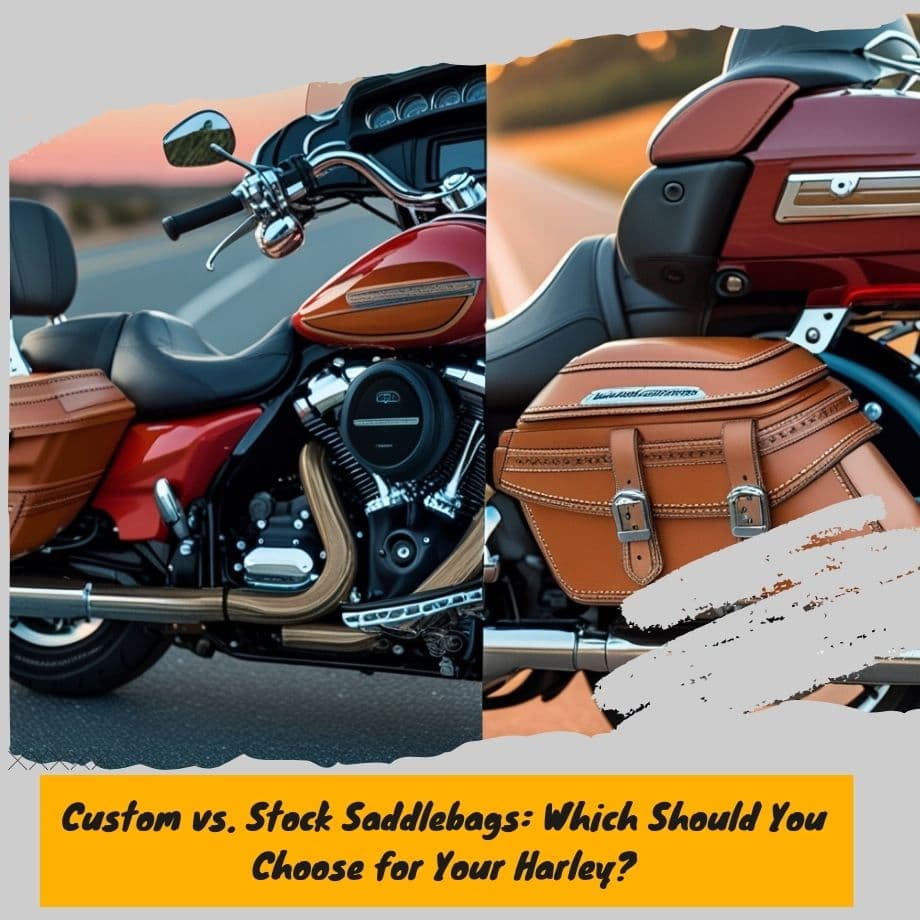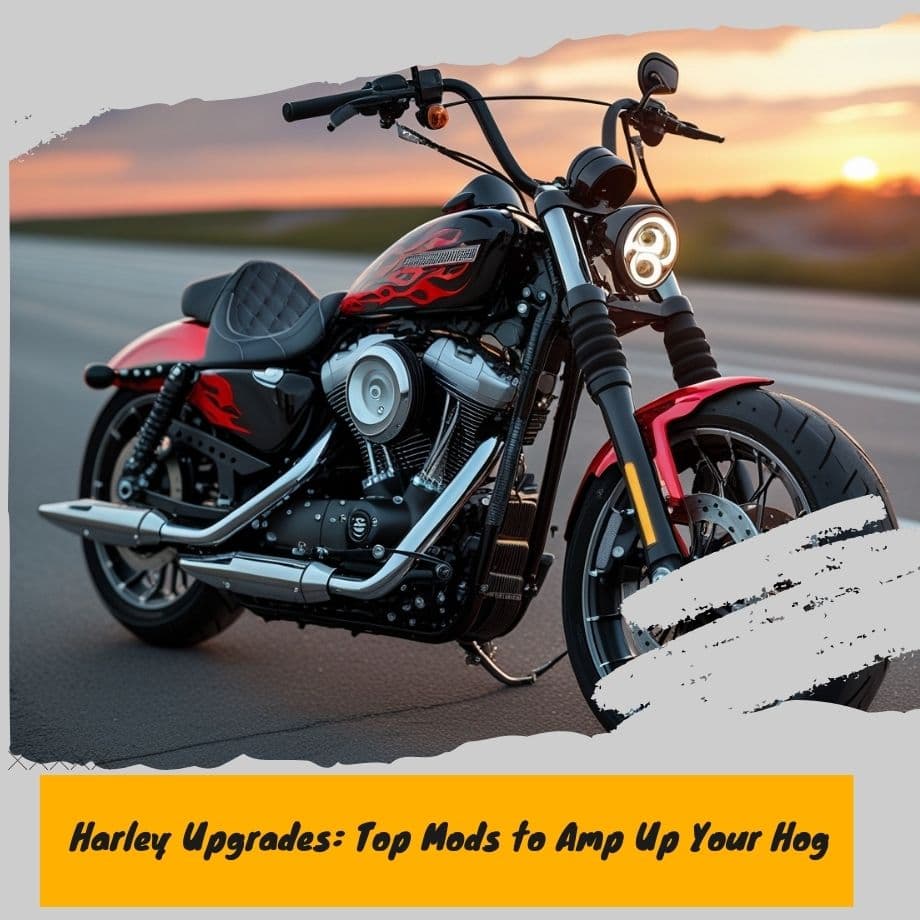A Hard & Handsome Storage Option For Your Hog

What Are Hard Bags?
Hard bags, also known as hard saddlebags or hard panniers, are rigid luggage cases designed specifically for motorcycles. Unlike soft luggage, which is made of flexible materials like leather or textile, hard bags are constructed with a solid outer shell, typically made of materials like fiberglass, plastic, or aluminum.
The primary purpose of hard bags is to provide secure and weatherproof storage for your belongings while riding. Their rigid construction offers superior protection against the elements, such as rain, wind, and debris, keeping your gear dry and safe.
Hard bags are particularly popular among touring and long-distance riders who need reliable storage solutions for extended trips.
One of the key advantages of hard bags over soft luggage is their durability and resistance to impacts. The solid outer shell acts as a barrier, shielding your belongings from potential scratches, dents, or damage that could occur during rides or accidental drops.
This added protection ensures your valuable items remain intact, even in challenging riding conditions.
Hard bags are often designed to seamlessly integrate with the motorcycle's frame, providing a sleek and streamlined appearance.
They can be mounted securely to the bike's rear or sides, ensuring a stable and balanced load distribution. This integration not only enhances the overall aesthetics but also contributes to improved handling and stability while riding.
In contrast to soft luggage, which can sag or deform under heavy loads, hard bags maintain their shape and structure, ensuring efficient use of storage space. This makes them ideal for carrying bulkier or irregularly shaped items that might not fit well in soft luggage compartments.
Benefits of Hard Bags for Harley Riders
Hard bags offer several benefits that make them a popular choice among Harley enthusiasts.
One of the primary advantages is the weather protection they provide. Unlike soft luggage, hard bags are typically made of durable materials like fiberglass or plastic, which can withstand rain, snow, and other harsh weather conditions, keeping your belongings dry and safe.
Another significant benefit of hard bags is the security they offer. Most hard bags come equipped with locking mechanisms, ensuring that your valuables remain secure while you're on the road. This added security feature provides peace of mind, especially when you need to leave your motorcycle unattended for a short period.
You May Also Like To Know About: CUSTOM LEATHER SADDLEBAGS
Durability is another key advantage of hard bags. Their rigid construction and sturdy materials make them resistant to impacts, scratches, and other potential damage that can occur during long rides or rough terrain. This durability ensures that your hard bags will last for years, providing reliable storage for your belongings.
Lastly, hard bags offer a stylish appearance that complements the rugged and classic look of Harley-Davidson motorcycles. Many manufacturers offer a variety of designs and finishes, allowing riders to choose hard bags that best suit their personal style and the overall aesthetic of their bike.
Popular Hard Bag Materials
When it comes to hard bags for Harley-Davidson motorcycles, several materials are commonly used, each with its own set of advantages and drawbacks. Let's explore the most popular options:
Fiberglass
Fiberglass is a lightweight yet sturdy material that has been a staple in the motorcycle industry for decades.
Fiberglass hard bags are known for their durability and resistance to dents, scratches, and impacts. They are also relatively inexpensive compared to other materials. However, fiberglass can be prone to cracking or shattering under extreme stress, and it may not offer the same level of weather resistance as other materials.
ABS Plastic
ABS (Acrylonitrile Butadiene Styrene) plastic is another popular choice for hard bags. ABS is lightweight, impact-resistant, and can be molded into various shapes and sizes.
ABS hard bags are often more affordable than their fiberglass counterparts and offer excellent weather resistance. However, they may not be as durable as fiberglass in the long run and can be susceptible to fading or discoloration from prolonged exposure to sunlight.
Aluminum
Aluminum hard bags are prized for their strength, durability, and sleek appearance. These bags are virtually indestructible and can withstand the toughest conditions on the road.
Aluminum is also highly resistant to corrosion and weathering, ensuring your hard bags maintain their pristine condition for years to come. On the downside, aluminum hard bags can be significantly more expensive than fiberglass or ABS options, and they are generally heavier, which can impact your motorcycle's performance and fuel efficiency.
Carbon Fiber
For riders seeking the ultimate in lightweight and high-performance hard bags, carbon fiber is an excellent choice. Carbon fiber is incredibly strong and rigid yet remarkably lightweight, making it an ideal material for motorcycle luggage. Carbon fiber hard bags are also highly resistant to impact, scratches, and weathering.
However, they come with a premium price tag and may be more susceptible to cracking or shattering under extreme stress compared to other materials.
Ultimately, the choice of material for your hard bags will depend on your budget, priorities, and personal preferences. Each option has its strengths and weaknesses, so it's essential to weigh the pros and cons carefully before making a decision.
Hard Bags, Fiberglass Saddlebags, Hard Shell Saddle Bags
When it comes to hard bags for your Harley, you'll often encounter terms like "fiberglass saddlebags" and "hard shell saddle bags." While they may sound similar, there are some subtle differences between these types of hard luggage.
Fiberglass Saddlebags
are a popular choice among Harley riders. As the name suggests, these bags are constructed from fiberglass, a lightweight yet durable material.
Fiberglass saddlebags are known for their strength and resistance to impacts, making them ideal for long-distance touring or off-road adventures. They typically feature a smooth, glossy finish and can be painted to match the color scheme of your bike.
Hard Shell Saddle Bags
on the other hand, are often made from materials like ABS plastic or composite materials. These bags offer a rigid, hard-sided structure that provides excellent protection for your belongings.
Hard shell saddle bags are designed to withstand the rigors of the road and can be locked for added security. They may have a more rugged, textured appearance compared to fiberglass saddlebags.
Both fiberglass saddlebags and hard shell saddle bags share some common characteristics. They are designed to be mounted on the rear of your Harley, providing ample storage space for your gear, tools, and essentials.
These hard bags offer superior protection against the elements, keeping your belongings dry and secure, regardless of the weather conditions.
However, there are a few key differences to consider. Fiberglass saddlebags tend to be slightly lighter than their hard shell counterparts, which can be beneficial for weight distribution and fuel efficiency.
Hard shell saddle bags, on the other hand, may offer better impact resistance and a more rigid structure, making them ideal for carrying heavier or more fragile items.
Ultimately, the choice between fiberglass saddlebags and hard shell saddle bags comes down to personal preference, intended use, and the specific features you prioritize. Both options provide a durable and practical solution for carrying your gear on your Harley adventures.
Mounting and Installation
Mounting and installing hard bags on your Harley-Davidson motorcycle is a straightforward process, but it's crucial to follow the manufacturer's instructions carefully. Most hard bags are designed to be mounted on the motorcycle's frame or rear fender using specific mounting hardware and brackets.
One common mounting method involves using docking points or mounting studs on the motorcycle's frame. The hard bags typically come with mounting brackets that attach to these docking points, allowing the bags to be securely mounted and easily removed when needed.
Another popular mounting option is to use saddlebag guards or supports that attach to the rear fender or frame. These guards provide a stable platform for the hard bags to rest on and are often adjustable to accommodate different bag sizes and shapes.
When installing hard bags, it's essential to ensure a proper fit and secure mounting. Loose or improperly mounted bags can shift during riding, causing potential damage or safety hazards. Always double-check the mounting hardware and tighten all bolts and fasteners according to the specified torque values.
Some installation tips for hard bags include:
- Read the instructions thoroughly: Familiarize yourself with the mounting process and required tools before starting.
- Prepare the mounting area: Clean the mounting surfaces and ensure they are free from debris or obstructions.
- Use the correct hardware: Only use the mounting hardware provided by the manufacturer or recommended replacements.
- Torque properly: Follow the recommended torque values for bolts and fasteners to ensure a secure fit.
- Check clearance: Ensure the hard bags have adequate clearance from the motorcycle's components and do not interfere with the suspension or other moving parts.
- Test fit: Before fully tightening the mounting hardware, test fit the bags and make any necessary adjustments for proper alignment and clearance.
Capacity and Storage Space
When it comes to hard bags for your Harley, capacity and storage space are crucial factors to consider. These rugged saddlebags come in various sizes to accommodate your touring and storage needs.
Typically, hard bags range from compact models offering around 20-30 liters of storage space to larger options that can hold a whopping 60 liters or more.
One of the advantages of hard bags is their ability to maximize internal space while maintaining a sleek, streamlined exterior.
Many models feature clever design elements, such as expandable sides or removable interior dividers, allowing you to adjust the storage capacity based on your specific requirements.
For shorter rides or solo adventures, compact hard bags with dimensions around 16 inches wide, 10 inches high, and 10 inches deep can provide ample room for essentials like a spare change of clothes, tools, and snacks.
These smaller options often have a combined storage capacity of 40-50 liters, making them a practical choice for day trips or weekend getaways.
If you're planning longer tours or prefer to travel with more gear, larger saddlebags can be a game-changer. Some popular models measure around 21 inches wide, 13 inches high, and 13 inches deep, offering a combined capacity of up to 90 liters or more.
These spacious bags can comfortably accommodate camping equipment, extra clothing, and even small coolers, ensuring you have everything you need for an extended journey.
It's worth noting that the dimensions and capacity of hard bags can vary slightly between manufacturers and models, so it's always a good idea to consult the specifications provided by the brand before making your purchase.
By carefully considering your storage needs and matching them with the appropriate hard bag size, you can enjoy the perfect balance of ample space and a sleek, streamlined look on your Harley.
Locking Mechanisms and Security
One of the key advantages of hard bags over soft luggage is the added security they provide for your belongings.
Most quality hard bags come equipped with built-in locking mechanisms that allow you to secure your gear and valuables while on the road. This peace of mind is invaluable for any rider, especially those embarking on long-distance adventures or touring trips.
Hard bags typically feature sturdy locking systems integrated into the design, ensuring that your belongings remain safe and protected from opportunistic thieves. Many models offer simple yet effective latch-and-lock mechanisms, while others boast more advanced security features like tamper-resistant locks or even keyless entry systems.
When selecting hard bags for your Harley, it's essential to consider the locking mechanisms and overall security they provide.
Look for bags with robust locks that can withstand potential prying or tampering attempts. Additionally, consider the ease of use and convenience of the locking system, as you'll be accessing your gear frequently during your rides.
With the right hard bags, you can ride with confidence, knowing that your valuables are secure and protected within their hard shell exterior.
This added security not only provides peace of mind but also allows you to fully immerse yourself in the riding experience without worrying about the safety of your belongings.
Loading and Packing Tips
Proper loading and packing of your hard bags is crucial for a comfortable and safe ride. Here are some best practices to follow:
Weight Distribution
Evenly distribute the weight across the bags and keep heavier items closer to the bike. Uneven weight distribution can affect handling and stability, especially at higher speeds or when making sharp turns. Aim for a balanced load on both sides.
Secure the Load
Make sure all items are securely packed inside the bags to prevent shifting or rattling during the ride. Use straps, bungee cords, or other tie-downs to secure loose items if necessary.
Pack Efficiently
Utilize the available space efficiently by packing smaller items into the nooks and crannies. Roll up clothes and use packing cubes or compression bags to maximize space. Keep frequently accessed items easily accessible.
Protect Fragile Items
Wrap fragile items, such as electronics or glassware, in protective padding or bubble wrap to prevent damage from vibrations or impacts.
Waterproof Protection
While hard bags offer some protection from the elements, it's always a good idea to use waterproof bags or covers for sensitive items, especially during inclement weather.
Balance and Visibility
Be mindful of the overall size and shape of your loaded bags. Avoid overloading or creating an unbalanced load that could obstruct your visibility or affect the bike's handling.
Remember, proper loading and packing not only ensure a comfortable ride but also help maintain the stability and control of your Harley-Davidson motorcycle.
Hard Bag Maintenance and Care
Proper maintenance and care are essential to keep your hard bags looking great and performing optimally for years to come.
Regular cleaning is crucial to remove dirt, grime, and road debris that can dull the finish and cause premature wear. Use a mild soap and water solution, along with a soft cloth or sponge, to gently wash the bags. Avoid harsh chemicals or abrasive cleaners that could damage the surface.
To protect the finish and maintain a lustrous shine, consider applying a high-quality protectant or wax designed specifically for your bag's material, whether it's fiberglass, ABS plastic, or another hard shell.
These products create a protective barrier against UV rays, road salt, and other environmental factors that can cause fading or discoloration.
Preventing scratches and damage is also important. Be mindful when loading and unloading your bags, and avoid placing sharp or abrasive objects directly against the interior surfaces.
Consider using soft liners or packing materials to protect the inside of the bags. Additionally, be cautious when riding in areas with low-hanging branches or tight spaces that could potentially scratch or dent the hard shell.
Regular inspections are recommended to check for any cracks, chips, or other damage that may compromise the structural integrity or weather-resistance of your hard bags. Addressing any issues promptly can prevent further deterioration and extend the lifespan of your bags.
By following these simple maintenance and care tips, your hard bags will not only look their best but also provide reliable storage and protection for your belongings on every Harley adventure.
Hard Bags vs. Soft Luggage
When it comes to motorcycle luggage, riders have the choice between hard bags and soft luggage. Both options have their own advantages and disadvantages, and the decision ultimately depends on personal preferences and riding needs.
Hard Bags:
Pros:
- Offer superior protection for your belongings against weather elements, road debris, and potential impacts.
- Provide a more secure storage solution with lockable lids or compartments.
- Maintain their shape and structure, allowing for better organization and easier access to your gear.
- Often have a sleeker and more integrated appearance with the motorcycle's design.
- Can be easily removed or installed, depending on your luggage needs.
Cons:
- Typically more expensive than soft luggage options.
- Can add significant weight to the motorcycle, affecting handling and fuel efficiency.
- Limited in terms of expandability or compression for varying load sizes.
- May require specific mounting hardware or modifications to the motorcycle.
Soft Luggage:
Pros:
- Generally more affordable than hard bags.
- Lightweight and less likely to affect the motorcycle's handling significantly.
- Offer greater flexibility and expandability for varying load sizes.
- Can be easily stored or transported when not in use.
- Typically easier to install or remove from the motorcycle.
Cons:
- Provide less protection for your belongings against the elements and potential impacts.
- May not have lockable compartments, making security a concern.
- Can become misshapen or lose their structure over time, especially when heavily loaded.
- May not integrate as seamlessly with the motorcycle's design as hard bags.
Ultimately, the choice between hard bags and soft luggage comes down to your priorities. If you value maximum protection, security, and a more integrated look, hard bags may be the way to go.
However, if you prioritize affordability, lightweight, and flexibility, soft luggage could be a better fit. Many riders opt for a combination of both types, using hard bags for long-distance touring and soft luggage for shorter trips or additional storage needs.







Leave a comment